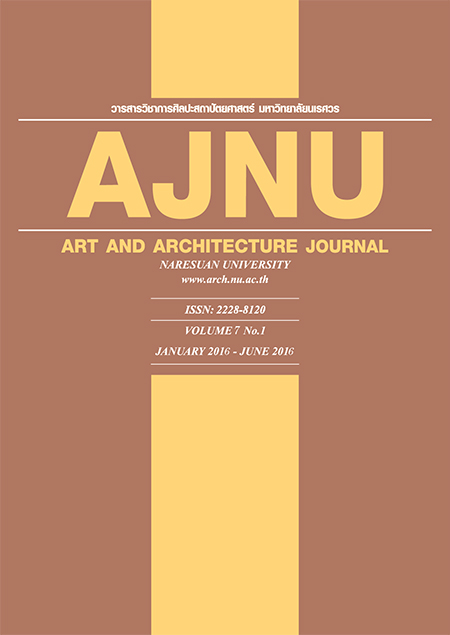Guidelines of Wall Material Manufacturing : Soil Interlocking-block from Waste Ceramic for Energy Efficiency
Main Article Content
Abstract
จังหวัดลำปางมีเศษเซรามิกเหลือทิ้งจากโรงงานอุตสาหกรรมเซรามิกเป็นจำนวนมากที่ไม่สามารถนำกลับมาใช้ใหม่ได้
เศษเซรามิกเหล่านี้ก่อให้เกิดมลภาวะต่อสิ่งแวดล้อมโดยรอบและยังยากแก่การย่อยสลายยาก และเพื่อนำเอาคุณสมบัติเด่นของ
การเป็นฉนวนความร้อน ให้อยู่ในรูปของบล็อกดินประสานที่มีคุณสมบัติของการเป็นลดการนำความร้อนด้วยเช่นกัน จึงมี
แนวความคิดที่จะศึกษาถึงการนำเศษเซรามิกเหลือทิ้งเหล่านี้นำกลับมาใช้ใหม่ จากการทดสอบประสิทธิภาพลดการนำความร้อน
พบว่าในเวลา 08.00 น ถึง 16.00 น คือช่วงเวลาที่บล็อกดินประสานในอัตราส่วน 1:5:0 1:4:1 และ 1:3:2 (ปูนซีเมนต์:ดินผสม:
เซรามิก) ได้รับความร้อนจากดวงอาทิตย์ โดยมีปริมาณพื้นที่ใต้กราฟเท่ากับ 25.33 , 20.36 และ 19.73 ตามลำดับ โดยบล็อกดิน
ประสานผสมเซรามิก 1:4:1 และ 1:3:2 นั้นมีพื้นที่ใต้กราฟที่น้อยกว่าบล็อกดินประสาน 1:5:0 แสดงให้เห็นถึงความแตกต่างของ
อุณหภูมิอากาศภายในและอุณหภูมิภายนอกที่น้อยกว่า ดังนั้นบล็อกดินประสาน 1:5:0 จึงมีประสิทธิภาพในการลดการนำความ
ร้อน
Lampang province has a large amount of industrial ceramics waste. Since those ceramics waste are
not reusable, they cause environmental pollution and are non-biodegradable. With ceramics’ outstanding
properties as thermal insulation and efficiency by reducing heat conduction, ceramics are used as the
ingredient to produce interlocking block. Thus, the idea of reusing ceramic remains is generated. The results
of testing the efficiency by reducing heat conduction showed as follows. During 08.00-16.00 hrs when
exposed to the sun, interlocking block at three different conditions: 1:5:0,1:4:1, and 1:3:2 cement-soil
mixture-ceramic ratio had the area under the curve of 25.33 , 20.36 and 19.73, respectively. The blocks with
1:4:1 and 1:3:2 cement-soil mixture-ceramic ratios had less area under the curve than those with 1:5:0 ratio.
This implied that the difference between internal and external temperature of the formers had lower than
that of the latter. Thus, the formers (The blocks with 1:5:0 ratios) had efficiency by reducing heat
conduction.

